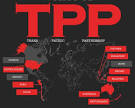Trans-Pacific Partnership: Opportunities for international trade and economic growth
Friday, December 19,2014
AsemconnectVietnam - The Trans-Pacific Partnership (TPP) offers an opportunity for the United States to increase trade with 11 other countries. Completing the agreement will create the largest free trade area, in terms of both goods and services, in which the United States participates.
Overall, the Asia-Pacific region presents some of the world’s most sought-after business opportunities, accounting for 60 percent of global Gross Domestic Product and 50 percent of international trade. However, in order to expand trade with the Asia-Pacific region and grow the domestic economy, President Obama will need Trade Promotion Authority (TPA) from Congress in order to bring TPP negotiations to a successful conclusion. Consider:
The proposed Trans-Pacific Partnership agreement will generate a higher level of trade than the North American Free Trade Agreement (NAFTA) of Canada, Mexico and the United States.
Combined trade of existing and potential goods and services of the TPP, both imports and exports, will exceed the combined trade due to agreements the United States has with Australia, Singapore, South Korea and NAFTA.
Originally a trade agreement among Brunei, Chile, New Zealand and Singapore, the TPP could soon expand to 12 more countries, including the United States. The TPP has been described as a “comprehensive and high-standard” trade agreement. Liberalizing trade in nearly all goods and services, the TPP exceeds the commitments established in the World Trade Organization, increasing the ability to make agreements with other WTO members and non-WTO members. For the United States, specifically, the TPP would aid in establishing market access in Japan, Malaysia, Vietnam and other countries. The United States already has trade agreements with some current and potential TPP countries; however, the TPP calls for commitments that will improve the transparency and consistency of the regulatory environment. Other benefits, according to the U.S. Trade Representative, include groundbreaking new rules on state-owned enterprises, a robust and balanced intellectual property rights framework and a thriving digital economy.
Benefits from joining the TPP would amount to $50 billion in 2015, growing to $140 billion annually by 2025. Indeed, all TPP nations would gain significant net income and exports by 2025 due to trade liberalization:
- Overall, by 2025, the TPP would generate $590 billion annually in income gains.
- By 2025, the TPP would increase exports 2.5 percent to 37.3 percent for each participating country, on average.
- Japan gains the most as a result of the TPP - $119 billion in income and $176 billion in exports by 2025, reflecting an increase in foreign investment due to liberalization of Japan’s investment and service sectors.
Small Businesses, International Trade. The TPP aims to foster economic integration across the Asia-Pacific region through trade. One of the first actions of the TPP was a call for a 90 percent reduction in all tariffs between member countries by 2016. By reducing trade barriers, such as high tariffs, U.S. participation in the TPP will encourage smaller businesses to trade internationally.
The Office of the United States Trade Representative (USTR) has consulted with small businesses to better understand the issues they face in trying to compete in the Asia-Pacific region and globally. The Asia-Pacific Economic Cooperation forum on small businesses told the USTR the key barriers they face are related to “tariffs, different rules of origin in different agreements, complex customs procedures, regulatory and other non tariff barriers, and the difficulty of accessing the laws, regulations, and other information about foreign markets.”
By looking at past free trade agreements, we can see how trade liberalization has paved the way for increased U.S. competitiveness and increased U.S. exports. For instance, NAFTA led to an increase in overall trade, including U.S. exports. According to the U.S. Chamber of Commerce:
- More than 122,000 U.S. small businesses exported to Canada and Mexico in 2010, representing more than 95 percent of U.S. exporters to the NAFTA market.
- Their exports topped $78 billion in 2009, representing 29 percent of all small business exports worldwide.
Today, 98 percent of all exporters and 97 percent of all importers are small businesses, representing almost 40 percent of U.S. goods exports and 31.5 percent of U.S. goods imports.
- With the help of the TPP, these small businesses will have the opportunity to take advantage of reduced tariffs and improved market access, increasing their global competitiveness.
Focus on Asia. The TPP will increase trade between the United States and some of its main trade partners. The partnership represents 40 percent of all U.S. trade and 25 percent of U.S. services trade. Given the TPP’s focus on the Asia-Pacific region, the United States will have the opportunity to expand in an economically driven region. Japan is the third largest trading partner in the TPP, as well as one of the negotiating parties with whom the United States does not already have a free trade agreement. However, with Japan accounting for 6 percent of all U.S. goods trade and 7 percent of all U.S. services trade, free trade between Japan and the United States could significantly increase U.S. economic involvement with Japan, perhaps including small businesses that are currently prevented from participating by high tariffs.
Conclusion. As with the North American Free Trade Agreement, the Trans-Pacific Partnership will have a positive effect on small businesses, increasing their access to, and allowing them to compete more effectively in, the world market. Given that a very large number of U.S. exporters are small businesses, a competitive United States means a competitive small business sector.
Source: bloomberg.com
Mining Vietnam 2024 opens in Hanoi
Vietnam attends Asia’s biggest food, hospitality expo in Singapore
Vietnam an attractive destination for electronics, semiconductor investors: Official
Vietnam becomes biggest rice supplier for Singapore
Vietnam among top domestic infrastructure investors: Ambassador
Standard Chartered, US promote clean energy investments in Vietnam
Vietnam, Russia’s Zabaikal region enhance cooperation
Hai Phong Techfest connects Vietnamese, RoK businesses
Made-in-Vietnam wind turbine towers bound for RoK
Vietnam-Laos-Cambodia-Thailand trade fair opens in Laos
NA Chairman meets with executives of large Chinese groups
Vietnam, Laos sign new trade agreement
French businesses interested in Vietnamese market
Vietnam, Russia discuss stronger agriculture cooperation

Plan of Hai Duong province for a period of 2021 - 2030, ...
Organize space reasonably and harmoniously, focusing on connecting Hai Duong in common development space, actively contributing to the ...Plan of Hau Giang province in a period of 2021 - 2030, ...
Sustainable forestry development program in a period of ...

12th-century ancient road unearthed at My Son Sanctuary
An ancient road dating back to the 12th century has freshly been discovered in an excavation on architectural ruins at the east side of ...Efforts made to seek UNESCO’s recognition for Con Moong ...
Vietnam Art Photo Contest and Exhibition 2024 to be held ...
Bas-relief featuring talks between Uncle Ho and soldiers ...



